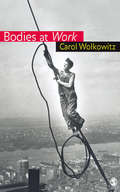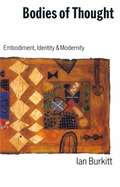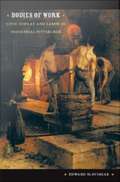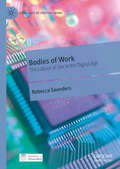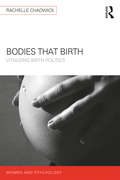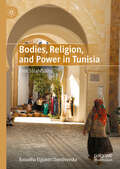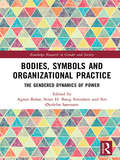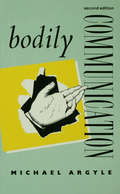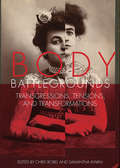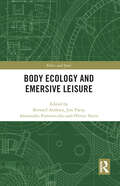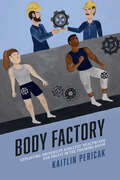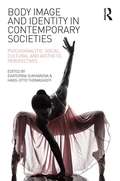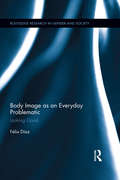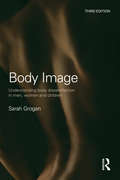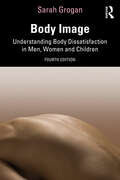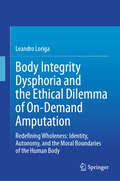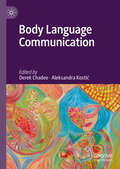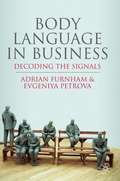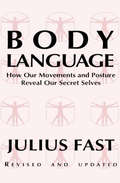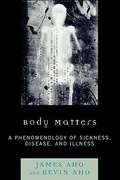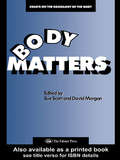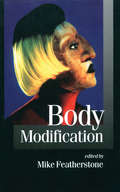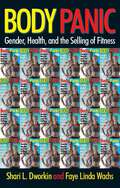- Table View
- List View
Bodies at Risk: An Ethnography of Heart Disease
by Elizabeth E. WheatleyIn Bodies at Risk, Elizabeth Wheatley provides a fascinating ethnography of heart disease. She looks at what happens to someone after a heart attack and how they get on with 'business as usual' in the wake of a potentially fatal medical crisis. How are daily routines, personal identities, families, friends, and careers affected and rearranged after diagnosis and treatment? This book examines the unfinished business of having and handling heart disease. The research is based on one-on-one and collective interviews, focus groups and participant observation in hospitals, cardiac rehabilitation clinics, and in people's homes. As heart disease is one of the major causes of death in the western world, this book is both timely and important. It is inspired by and contributes to sociological writing on the body, risk, experiences of illness, and medicalization, and will appeal to academics and students in these areas as well as in cultural studies, health-related consumption, health promotion and qualitative health research.
Bodies at Work (Sociology Ser.)
by Dr Carol Wolkowitz'After reading this book it will be more difficult to "do" the sociology of work and the sociology of the body in the absence of the other. In some quite exquisite ways it throws down a challenge which practitioners in both fields will find difficult to ignore' - Paul Stewart, former editor of Work, Employment and Society, University of the West of England Bodies at Work provides the first full-length, accessible account of the body/work relation in contemporary western societies. Bringing together fields of sociology that have hitherto developed mainly along separate lines, the book demonstrates the relevance of concepts developed in the sociology of the body for enriching our understanding of changing patterns of work and employment. Bodies at Work begins by establishing key concerns in both the sociology of the body and the sociology of work. Drawing on existing research, the author proceeds to examine a wide range of employment sectors: industrial employment; customer relations; health practice; care work; the beauty industry; and sex work. The contribution of feminist theory and research is highlighted throughout, and analyses of photographs help the reader conceptualise the changing nature of the body/work relationship over time. Bodies at Work helps readers think more clearly and creatively about how work relations shape bodily experience.
Bodies of Thought: Embodiment, Identity and Modernity
by Ian BurkittIn this incisive and truly impressive book, Ian Burkitt critically addresses the dualism between mind and body, thought and emotion, rationality and irrationality, and the mental and the material, which haunt the post-Cartesian world. Drawing on the work of contemporary social theorists and feminist writers, he argues that thought and the sense of being a person is inseparable from bodily practices within social relations, even though such active experience may be abstracted and expanded upon through the use of symbols. Overcoming classic dualisms in social thought, Burkitt argues that bodies are not purely the constructs of discourses of power: they are also productive, communicative, and invested with powerful capacities for changing the social and natural worlds. He goes on to consider how such powers can be developed in more ethical forms of relations and activities.
Bodies of Work: Civic Display and Labor in Industrial Pittsburgh
by Edward SlavishakBy the end of the nineteenth century, Pittsburgh emerged as a major manufacturing center in the United States. Its rise as a leading producer of steel, glass, and coal was fueled by machine technology and mass immigration, developments that fundamentally changed the industrial workplace. Because Pittsburgh's major industries were almost exclusively male and renowned for their physical demands, the male working body came to symbolize multiple often contradictory narratives about strength and vulnerability, mastery and exploitation. In Bodies of Work, Edward Slavishak explores how Pittsburgh and the working body were symbolically linked in civic celebrations, the research of social scientists, the criticisms of labor reformers, advertisements, and workers' self-representations. Combining labor and cultural history with visual culture studies, he chronicles a heated contest to define Pittsburgh's essential character at the turn of the twentieth century, and he describes how that contest was conducted largely through the production of competing images. Slavishak focuses on the workers whose bodies came to epitomize Pittsburgh, the men engaged in the arduous physical labor demanded by the city's metals, glass, and coal industries. At the same time, he emphasizes how conceptions of Pittsburgh as quintessentially male limited representations of women in the industrial workplace. The threat of injury or violence loomed large for industrial workers at the turn of the twentieth century, and it recurs throughout Bodies of Work: in the marketing of artificial limbs, statistical assessments of the physical toll of industrial capitalism, clashes between labor and management, the introduction of workplace safety procedures, and the development of a statewide workmen's compensation system.
Bodies of Work: The Labour of Sex in the Digital Age (Dynamics of Virtual Work)
by Rebecca SaundersThis book is a timely and innovative exploration of the vital relationship between sex and capitalism in the digital age. It provides a lively, provocative analysis of how specifically digital forms of capitalist accumulation and labour shape and discipline the contemporary sexual body. Rebecca Saunders focuses on pornography in order to investigate the impact of digital forms of capitalism on contemporary sexuality and reveals the centrality of pornography to the digital attention economy, affective economics, the information economy, the creative industries and neoliberalism. Saunders uncovers a fundamental shift in the aesthetics and meaning of pornographic film, from a genre concerned with representing sexual pleasure to one that has become focused on representing sex as labour. Contemporary pornographic film is therefore read as a sign and symptom of how digital forms of capitalism regulate the twenty-first century sexual body through digital interfaces and technologies. Bodies of Work analyses major porn studios, dominant streaming platforms, significant directors and performers and queer and alternative pornographies, and presents new and significant concepts such as sexual datafication, the labour of visibility and interventionist pornography. Discussing pornographic film, sexuality, digital culture, labour and capitalism, this book will be of interest to students and scholars across gender studies, media and cultural studies, digital humanities and economics.
Bodies that Birth: Vitalizing Birth Politics (Women and Psychology)
by Rachelle ChadwickBodies that Birth puts birthing bodies at the centre of questions about contemporary birth politics, power, and agency. Arguing that the fleshy and embodied aspects of birth have been largely silenced in social science scholarship, Rachelle Chadwick uses an array of birth stories, from diverse race-class demographics, to explore the narrative entanglements between flesh, power, and sociomateriality in relation to birth. Adopting a unique theoretical framework incorporating new materialism, feminist theory, and a Foucauldian ‘analytics of power’, the book aims to trace and trouble taken-for-granted assumptions about birthing bodies. Through a diffractive and dialogical approach, the analysis highlights the interplay between corporeality, power, and ideologies in the making of birth narratives across a range of intersectional differences. The book shows that there is no singular birthing body apart from sociomaterial relations of power. Instead, birthing bodies are uncertain zones or unpredictable assortments of physiology, flesh, sociomateriality, discourse, and affective flows. At the same time, birthing bodies are located within intra-acting fields of power relations, including biomedicine, racialized patriarchy, socioeconomics, and geopolitics. Bodies that Birth brings the voices of women from different sociomaterial positions into conversation. Ultimately, the book explores how attending to birthing bodies can vitalize global birth politics by listening to what matters to women in relation to birth. This is fascinating reading for researchers, academics, and students from across the social sciences.
Bodies, Religion, and Power in Tunisia: Free Sâlah/Sâlha
by Raoudha Elguedri DumbrovskaThis book explores the body as a vector for reading the rapid changes in contemporary Tunisia through questions of sexuality, forms of clothing, and the dynamics of gender relations. Grounded in 15 years of sociological empirical research on the post-revolutionary period of Tunisia (2011-2020), this study addresses youth uprisings, through their bodies, against the dualities of traditional and modern, masculinity and femininity, and the legitimate and the marginal. Bringing together empirical research and a theoretical overview of the evolution of the place of the body in sociology and feminist theory, this book deconstructs biological, deterministic views of the body and offers instead a perspective of the body as interactive, subjective, societal, and cosmic, permeated by different systems, policies, philosophies, and ways of living. Chapters analyse Arab and Islamic cultural and cognitive frameworks for the body and apply Foucauldian and feminist concepts of the body and power to provide a comparative sociological study of global politics around the body while centering Tunisian youth movements that demand free use of the body. It will be of interest to students and researchers in Women, Gender, and Sexuality Studies, Sociology of the Body, Middle Eastern Studies, and Feminist Theory.
Bodies, Symbols and Organizational Practice: The Gendered Dynamics of Power (Routledge Research in Gender and Society)
by Agnes Bolsø Stine Helena Svendsen Siri Øyslebø SørensenDespite all the efforts to promote change, power and authority still seem to be permanently associated with the white, the straight and the masculine, both symbolically and in the everyday world of organizations. As the intricate relationship between the symbolic and the everyday remains under-researched, this anthology proposes a transdisciplinary feminist perspective drawing on the humanities in order to explore the complex nature of the gendered politics of organizations. Indeed, analyzing how images, narratives, symbols and bodies are all part of how power and gender are constructed in organizations through a broad and international range of empirical studies, Bodies, Symbols and Organizational Practice explores issues at the interstices of the humanities and social sciences, combining theoretical and analytical perspectives from both areas. Providing a radical analysis of the gendered dynamics of power as well as petitioning for radical intervention into those dynamics, this timely volume will appeal to postgraduate students and postdoctoral researchers interested in fields such as: Organization and Management Studies, Gender studies, Feminist theory and Sociology of Work & Industry.
Bodily Communication
by Michael ArgyleNon-verbal communication - the eye movements, facial expressions, tone of voice, postures and gestures that we all use more or less consciously and more or less effectively - can enhance or diminish every form of social interaction. Michael Argyle's second edition of Bodily Communication is an invaluable up-to-date guide for students of the subject. In the last ten years NVC has become recognized as an important part of social psychology and of professional training, particularly in social work, education and management.Greatly expanded from the first edition, and significantly revised, this second edition has two completely new chapters on social skills and personality, and a new chapter on research methods. The author, a pioneer in the study of non-verbal communication, presents the second edition in the same accessible style as the first, bringing to the reader both his intense interest in the subject and his authoritative knowledge of it.
Body Battlegrounds: Transgressions, Tensions, and Transformations
by Chris Bobel Samantha KwanBody Battlegrounds explores the rich and complex lives of society's body outlaws—individuals from myriad social locations who oppose hegemonic norms, customs, and conventions about the body. Original research chapters (based on textual analysis, qualitative interviews, and participant observation) along with personal narratives provide a window into the everyday lives of people rewriting the norms of embodiment in sites like schools, sporting events, and doctors' offices.Table of ContentsIntroduction | Chris Bobel and Samantha KwanPart I: Going "Natural"• Body Hair Battlegrounds: The Consequences, Reverberations, and Promises of Women Growing Their Leg, Pubic, and Underarm Hair | Breanne Fahs• Radical Doulas, Childbirth Activism, and the Politics of Embodiment | Monica Basile• Caring for the Corpse: Embodied Transgression and Transformation in Home Funeral Advocacy | Anne EsacoveLiving Resistance:• Deconstructing Reconstructing: Challenging Medical Advice Following Mastectomy | Joanna Rankin• My Ten-Year Dreadlock Journey: Why I Love the "Kink" in My Hair . . . Today | Cheryl Thompson• Living My Full Life: My Rejecting Weight Loss as an Imperative for Recovery from Binge Eating Disorder | Christina Fisanick• Pretty Brown: Encounters with My Skin Color | Praveena LakshmananPart II: Representing Resistance• Blood as Resistance: Photography as Contemporary Menstrual Activism | Shayda Kafai• Am I Pretty Enough for You Yet?: Resistance through Parody in the Pretty or Ugly YouTube Trend | Katherine Phelps• The Infidel in the Mirror: Mormon Women's Oppositional Embodiment | Kelly Grove and Doug SchrockLiving Resistance:• A Cystor's Story: Polycystic Ovarian Syndrome and the Disruption of Normative Femininity | Ledah McKellar• Old Bags Take a Stand: A Face Off with Ageism in America | Faith Baum and Lori Petchers• Making Up with My Body: Applying Cosmetics to Resist Disembodiment | Haley Gentile• I Am a Person Now: Autism, Indistinguishability, and (Non)optimal Outcome | Alyssa HillaryPart III: Creating Community, Disrupting Assumptions• Yelling and Pushing on the Bus: The Complexity of Black Girls' Resistance | Stephanie D. Sears and Maxine Leeds Craig• Big Gay Men's Performative Protest Against Body Shaming: The Case of Girth and Mirth | Jason Whitesel• "What's Love Got to Do with It?": The Embodied Activism of Domestic Violence Survivors on Welfare | Sheila M. KatzLiving Resistance:• "Your Signing Is So Beautiful!": The Radical Invisibility of ASL Interpreters in Public | Rachel Kolb• Two Shakes | Rev. Adam Lawrence Dyer• "Showing Our Muslim": Embracing the Hijab in the Era of Paradox | Sara Rehman• "Doing Out": A Black Dandy Defies Gender Norms in the Bronx | Mark Broomfield• Everybody: Making Fat Radio for All of Us | Cat PauséPart IV: Transforming Institutions and Ideologies• Embodying Nonexistence: Encountering Mono- and Cisnormativities in Everyday Life | J. E. Sumerau• Freeing the Nipple: Encoding the Heterosexual Male Gaze into Law | J. Shoshanna Ehrlich• Give Us a Twirl: Male Baton Twirlers' Embodied Resistance in a Feminized Terrain | Trenton M. Haltom• "That Gentle Somebody": Rethinking Black Female Same-Sex Practices and Heteronormativity in Contemporary South Africa | Taylor RileyLiving Resistance:• Showing Up as Myself: Embodiment and Authenticity in the Classroom | Ryan Ambuter• Sitting and Resisting: How Using a Wheelchair Confronts Ideas of Normal | Margaret Stran• Against Diabetic Numerology in a Black Body, or, Why I Cannot Live by the Numbers | Anthony Ryan Hatch• My Women's Studies Professor Uses Botox? | Dana BerkowitzAfterword: Bodies of Resistance | Sonya Renee Taylor
Body Battlegrounds: Transgressions, Tensions, and Transformations
by Chris Bobel and Samantha KwanBody Battlegrounds explores the rich and complex lives of society's body outlaws—individuals from myriad social locations who oppose hegemonic norms, customs, and conventions about the body. Original research chapters (based on textual analysis, qualitative interviews, and participant observation) along with personal narratives provide a window into the everyday lives of people rewriting the norms of embodiment in sites like schools, sporting events, and doctors' offices.Table of ContentsIntroduction | Chris Bobel and Samantha Kwan Part I: Going "Natural" • Body Hair Battlegrounds: The Consequences, Reverberations, and Promises of Women Growing Their Leg, Pubic, and Underarm Hair | Breanne Fahs • Radical Doulas, Childbirth Activism, and the Politics of Embodiment | Monica Basile• Caring for the Corpse: Embodied Transgression and Transformation in Home Funeral Advocacy | Anne Esacove Living Resistance:• Deconstructing Reconstructing: Challenging Medical Advice Following Mastectomy | Joanna Rankin• My Ten-Year Dreadlock Journey: Why I Love the "Kink" in My Hair . . . Today | Cheryl Thompson• Living My Full Life: My Rejecting Weight Loss as an Imperative for Recovery from Binge Eating Disorder | Christina Fisanick• Pretty Brown: Encounters with My Skin Color | Praveena Lakshmanan Part II: Representing Resistance• Blood as Resistance: Photography as Contemporary Menstrual Activism | Shayda Kafai• Am I Pretty Enough for You Yet?: Resistance through Parody in the Pretty or Ugly YouTube Trend | Katherine Phelps• The Infidel in the Mirror: Mormon Women's Oppositional Embodiment | Kelly Grove and Doug Schrock Living Resistance:• A Cystor's Story: Polycystic Ovarian Syndrome and the Disruption of Normative Femininity | Ledah McKellar• Old Bags Take a Stand: A Face Off with Ageism in America | Faith Baum and Lori Petchers• Making Up with My Body: Applying Cosmetics to Resist Disembodiment | Haley Gentile• I Am a Person Now: Autism, Indistinguishability, and (Non)optimal Outcome | Alyssa Hillary Part III: Creating Community, Disrupting Assumptions• Yelling and Pushing on the Bus: The Complexity of Black Girls' Resistance | Stephanie D. Sears and Maxine Leeds Craig• Big Gay Men's Performative Protest Against Body Shaming: The Case of Girth and Mirth | Jason Whitesel• "What's Love Got to Do with It?": The Embodied Activism of Domestic Violence Survivors on Welfare | Sheila M. Katz Living Resistance:• "Your Signing Is So Beautiful!": The Radical Invisibility of ASL Interpreters in Public | Rachel Kolb• Two Shakes | Rev. Adam Lawrence Dyer• "Showing Our Muslim": Embracing the Hijab in the Era of Paradox | Sara Rehman• "Doing Out": A Black Dandy Defies Gender Norms in the Bronx | Mark Broomfield• Everybody: Making Fat Radio for All of Us | Cat Pausé Part IV: Transforming Institutions and Ideologies• Embodying Nonexistence: Encountering Mono- and Cisnormativities in Everyday Life | J. E. Sumerau• Freeing the Nipple: Encoding the Heterosexual Male Gaze into Law | J. Shoshanna Ehrlich• Give Us a Twirl: Male Baton Twirlers' Embodied Resistance in a Feminized Terrain | Trenton M. Haltom• "That Gentle Somebody": Rethinking Black Fema
Body Ecology and Emersive Leisure (Ethics and Sport)
by Bernard Andrieu Jim Parry Alessandro Porrovecchio Olivier SirostThe emerging field of body ecology offers fresh insights into how the body engages with its surrounding environment through consciousness, perception, knowledge and emotion. In this groundbreaking collection, leading scholars of sport, leisure and philosophy draw on research on topics as diverse as surfing, freediving, slacklining, parkour, bodybuilding, dance and circus arts to flesh out the concept of body ecology and its potential for helping us understand our connection with the world around us. Touching on theories of subjectivity, embodiment, pleasure and play, this book explores different approaches to studying body ecology as a way of conceptualising the experience of being immersed in nature, in the elements and in one’s own body through the power of awareness. An experience becomes emersive when it involves the production of new emotions in the body: emersion is the activation of what is living within the body itself. Shedding new light on the possibilities of physical cultural studies, Body Ecology and Emersive Leisure is fascinating reading for all students and scholars with an interest in sport, leisure, philosophy and the body.
Body Factory: Exploiting University Athletes' Healthcare for Profit in the Training Room (Sporting)
by Kaitlin PericakA university’s athletic training room is meant to care for and heal college athletes and ensure they are receiving the help they need. Although sports medicine staff members are sincere in their goal of centering athletes and providing the best healthcare possible, organizational constraints affect their approach. Chief among them is the pressure sports medicine staff members feel to keep athletes from profit-generating sports healthy enough to perform. Body Factory enters an NCAA Division I athletic training room to examine the disconnect between what the NCAA states as its goal of athlete healthcare and what is actually happening. Kaitlin Pericak conducts observations in this space and interviews injured athletes and sports medicine staff members to show how institutional control over “best interests” often ends up exploiting the individual athlete. The influences at work are part of a neoliberal paradigm that explains why interest in an athlete’s care is greatly diminished once they are injured and can no longer play. Body Factory considers how race, gender, and health before and after injury are deciding factors in these university training centers. The bureaucratic organization has a goal of maintaining power to generate profit, and Pericak shows this is almost always at the expense of the athlete.
Body Image and Identity in Contemporary Societies: Psychoanalytic, social, cultural and aesthetic perspectives
by Ekaterina Sukhanova Hans-Otto ThomashoffPopular interest in body image issues has grown dramatically in recent years, due to an emphasis on individual responsibility and self-determination in contemporary society as well as the seemingly limitless capacities of modern medicine; however body image as a separate field of academic inquiry is still relatively young. The contributors of Body Image and Identity in Contemporary Societies explore the complex social, political and aesthetic interconnections between body image and identity. It is an in-depth study that allows for new perspectives in the analysis of contemporary visual art and literature but also reflects on how these social constructs inform clinical treatment. Sukhanova and Thomashoff bring together contributions from psychoanalysts, psychotherapists, psychiatrists and scholars in the fields of the social sciences and the humanities to explore representations of the body in literature and the arts across different times and cultures. The chapters analyse the social construction of the 'ideal' body in terms of beauty, gender, sexuality, race, ethnicity, class and disability, from a broadly psychoanalytic perspective, and traces the mechanisms which define the role of the physical appearance in the formation of identity and the assumption of social roles. Body Image and Identity in Contemporary Societies' unique interdisciplinary outlook aims to bridge the current gap between clinical observations and research in semiotic theory. It will be of interest to psychoanalysts, psychotherapists, art therapists, art theorists, academics in the humanities and social sciences, and those interested in an interdisciplinary approach to the issues of body image and identity. Ekaterina Sukhanova is University Director of Academic Program Review at the City University of New York USA. She serves as Scientific Secretary of the Section for Art and Psychiatry and the Section of Art and Psychiatry of the World Psychiatric Association. She is also engaged in interdisciplinary research on cultural constructs of mental health and illness and curates exhibits of art brut as a vehicle for fighting stigma. Hans-Otto Thomashoff was born in Germany and lives in Vienna. He is a psychiatrist, psychoanalyst, art historian and author of fiction and non-fiction books. He has been curator of several art exhibitions highlighting the connection between the psyche and art as well as president of the section of Art and Psychiatry of the World Psychiatric Association and advisory committee member of the Sigmund Freud Foundation, Vienna.
Body Image as an Everyday Problematic: Looking Good (Routledge Research in Gender and Society)
by Félix Díaz MartínezIt is well known that body image has been associated to health risks related to eating habits. However, to what extent do identity categories, everyday social interaction and common discourses affect our preoccupations and sufferings related to body image in contemporary society, and our coordinated ways of confronting them? In Body Image as an Everyday Problematic, Diaz seeks to offer a comprehensive perspective on body image as an everyday problematic, grounded on verbal accounts of biographic experience. The main body of the book unfolds through five analyses: (1) a framework for how persons are categorized on the grounds of their beauty, weight, or physical appeal; with reference to heterosexual and friendship relations; (2) how men position themselves with respect to culturally provided images of beautiful women in relation to their heterosexual partners; (3) biographic processes through which people locate problems with the body, confront them and interpret them after some time; (4) the role of mothers in providing help across different kinds of problems; and (5) the experiences and contradictions of caring for relatives or partners who suffer for their body image. Indeed, these five analytical threads together compose a structured and rich understanding of the meaningful social order that lies at the core of our everyday preoccupations with the body. Challenging conventional psychological theories of body image, this enlightening volume will appeal to postgraduate students and postdoctoral researchers interested in fields such as Gender Studies, Clinical Psychology and Sociology.
Body Image: Understanding Body Dissatisfaction in Men, Women and Children
by Sarah GroganBody Image provides a comprehensive summary of research on body image in men, women, and children drawing together research findings from the fields of psychology, sociology, clothing, and gender studies. This third edition has been thoroughly revised and updated to reflect the significant increase in research on body image since the previous edition, as well as the significant cultural changes in how men’s and women’s bodies are viewed. Data are also included from interviews and focus groups with men, women, and children who have spoken about their experiences of body image and body dissatisfaction, producing a comprehensive understanding of how men and women construct and understand their bodies in the twenty-first century. The only sole-authored text to provide a comprehensive view of body image research, focusing on men, women, and children, Body Image will be invaluable to students and researchers, as well as practitioners with an interest in body image and how to reduce body dissatisfaction.
Body Image: Understanding Body Dissatisfaction in Men, Women and Children
by Sarah GroganFully revised and updated, Body Image 4th Edition provides a comprehensive summary of research on body image in men, women, and children drawing together research findings from the fields of psychology, sociology, and gender studies. The new edition presents all the latest research on body image including work on technology and body image, interventions to reduce body dissatisfaction, and links between body image, BMI, and clothing availability. Including data from interviews and focus groups with men, women, and children who have spoken about body image and its impact on the rest of their lives, the book explores a range of important contemporary issues, including the effects of social media and selfie-taking on body image, the work of activists and academics who are trying to change how the fashion industry presents women’s bodies, and new work investigating impacts of whole-body scanning technology and game-play avatars on appearance concern. Reflecting the direction of research on body image from a range of disciplines since the previous edition, the book also includes an increased focus on body image in men, looking at studies on pressures to be more muscular and toned, and evaluating the possible impacts on health-related behaviors such as exercise and body-related drug use. The only sole-authored text in the field, and integrating work from several disciplines, this is essential reading for students and researchers in psychology, sociology, computing science, sport and exercise science, and gender studies, with an interest in reducing body dissatisfaction in men, women and children.
Body Integrity Dysphoria and the Ethical Dilemma of On-Demand Amputation: Redefining Wholeness: Identity, Autonomy, and the Moral Boundaries of the Human Body
by Leandro LorigaThis book, explores the complex moral and ethical dilemmas surrounding Body Integrity Dysphoria (BID) and its recent classification in the ICD-11. The examination offers a pioneering view into a condition that remains deeply controversial within medical and public discourse. BID is characterised by a persistent desire to acquire a physical impairment, often through amputation. Such a situation forces the medical world to take a stance by either granting the amputation request or rejecting it with the risk of pushing individuals toward self-made solutions. Through a review of the contemporary understanding of BID as well as original data obtained during extensive fieldwork with medical professionals, this book addresses the ethical and moral aspects of the condition. Fundamental questions are posed about the relationship between bodily autonomy and embodiment, identity and gender, well-being and moral responsibility, and how these elements intertwine, shape and are shaped by sociocultural understanding of illness and body. The book aims to move beyond traditional understandings of body functionality to consider the implications of autonomy and the extent to which an individual considered mentally and physically sound can dispose of one's own body within the contemporary medical paradigm. This is done to question long-standing assumptions about bodily integrity and traditional views on the wholeness and naturalness of the human form. As postmodern theories challenge established frameworks, a paradigm shift emerges in medical and societal approaches to identity, embodiment, and impairment, and this needs to be addressed. Drawing on insights from medicine, psychology, sociology, and ethics, this book situates BID within a broader cultural and philosophical context. It raises essential questions about where individuals' rights intersect with medical responsibility and societal perceptions of normalcy and health. By doing so, the book provokes readers to reconsider the boundaries between health, pathology, and self-determination.
Body Language Communication
by Derek Chadee Aleksandra KostićThis book explores a number of important themes within body language discourse. The authors analyse the role of hands, touch, facial expression, misconceptions, and fallacious arguments in body language training. Other issues addressed include body language between humans and machines, lie detection, reactance and body language and thermography of the face. The authors work to determine various potentials of body language, and assess some areas of body language and role of body language in everyday life. They also discuss new perspectives and future directions in body language studies.
Body Language In Business
by Adrian Furnham Evgeniya PetrovaThis innovative new work clarifies the misconceptions aroundbody language while providing a scientific approach to understanding non-verbal communicationat work. The authors explain why it is so important to understand body language in business, combining hard research evidence with unambiguous tips and practical applications.
Body Language: The Essential Secrets Of Non-verbal Communication
by Julius FastA revised and updated edition of the New York Times–bestselling classic on understanding body language from the author of Subtext.Body Language helps you to understand the unconscious body movements and postures that provide intimate keys to what a person is really thinking and the secrets of their true inner selves. You will learn how to read the angle of shoulders, the tilt of a head, or the tap of a foot, in order to discern whether an individual is angry, frightened, or cheerful. You will be able to use Body Language to discover the most—and least—important person in any group by the way others position themselves. The body is not able to lie, for it sends subtle signals to those who know how to read them. Body Language will even show you how to do it without others knowing you are observing them. Body Language was a huge best seller when first published and has remained in print ever since. It has been thoroughly updated and revised especially for this ebook edition.
Body Matters: A Phenomenology of Sickness, Disease, and Illness
by James AhoFollowing the core principle of phenomenology as a return 'to the things themselves,' Body Matters attends to the phenomena of bodily afflictions and examines them from three different standpoints: from society in general that interprets them as 'sicknesses,' from the medical professions that interpret them as 'diseases,' and from the patients themselves who interpret them as 'illnesses.' By drawing on a crucial distinction in German phenomenology between two senses of the body_the quantifiable, material body (Ksrper) and the lived-body(Leib)_the authors explore the ways in which sickness, disease, and illness are socially and historically experienced and constructed. To make their case, they draw on examples from a multiplicity of disciplines and cultures as well as a number of cases from Euro-American history. The intent is to unsettle taken-for-granted assumptions that readers may have about body troubles. These are assumptions widely held as well by medical and allied health professionals, in addition to many sociologists and philosophers of health and illness. To this end, Body Matters does not simply deconstruct prejudices of mainstream biomedicine; it also constructively envisions more humane and artful forms of therapy.
Body Matters: Essays On The Sociology Of The Body
by David Morgan Sue ScottFocusing on the sociological embodiment of various "social actors", the authors consider the subsequent links with the constraints of daily life i.e. the male body, female therapists, body builders, marital and sexual counsellors, sex workers. They present recent or new research findings on aspects of the body, variants from what is conventionally seen as "natural" and consider and question aspects of self-image versus society's expectations. A number of developments in discussions of the body on such topics as feminist thought, the study of health and illness and cultural theory are presented as a series of essays which demonstrate the variety of interests mentioned.; The book is aimed at undergraduates/postgraduates students and lecturers in sociology, cultural studies, women's and gender studies.
Body Modification (Published in association with Theory, Culture & Society)
by Mike FeatherstoneThis fascinating collection explores the growing range of body modification practices such as piercing, tattooing, branding, cutting and inserting implants, which have sprung up recently in the West. It asks whether this implies that we are returning to traditional tribal practices of inscribing identities onto bodies on the part of ′modern primitives′, or is body modification better understood as purely cosmetic and decorative with body markings merely temporary signs of transferable loyalties?
Body Panic: Gender, Health, and the Selling of Fitness
by Faye Linda Wachs Shari L. DworkinDworkin and Wachs analyze 10 years of health and fitness magazines to uncover how bodies are made in popular cultureAre you ripped? Do you need to work on your abs? Do you know your ideal body weight? Your body fat index? Increasingly, Americans are being sold on a fitness ideal—not just thin but toned, not just muscular but cut—that is harder and harder to reach. In Body Panic, Shari L. Dworkin and Faye Linda Wachs ask why. How did these particular body types come to be “fit”? And how is it that having an unfit, or “bad,” body gets conflated with being an unfit, or “bad,” citizen?Dworkin and Wachs head to the newsstand for this study, examining ten years worth of men’s and women’s health and fitness magazines to determine the ways in which bodies are “made” in today’s culture. They dissect the images, the workouts, and the ideology being sold, as well as the contemporary links among health, morality, citizenship, and identity that can be read on these pages. While women and body image are often studied together, Body Panic considers both women’s and men’s bodies side-by-side and over time in order to offer a more in-depth understanding of this pervasive cultural trend.

